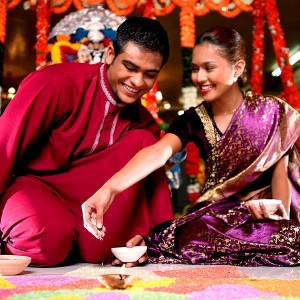At almost any time of year, some part of Malaysia is busy throwing a party. While the majority of Malaysian people follow the Islamic faith, the presence of many other cultures in the country means that a multitude of celebrations crowds the calendar. Traditional Chinese, Hindu, Buddhist, and indigenous tribal festivals have an honored place beside Malaysia’s secular and Islamic holidays. Malaysia’s cultures encourage everyone to participate; open house parties during Eid ul-Fitr typically include non-Muslim friends, and even Malay Muslims enjoy Chinese New Year celebrations. Thaipusam (between January to February) is celebrated by Malaysia’s Tamil Hindu community, although visitors are welcome to observe. Thaipusam is an annual feast honoring the Hindu god Subramaniam, or Lord Murugan. The most intense Thaipusam celebration in Malaysia occurs at Batu Caves in Gombak, Selangor, where a procession of devotees bearing colorful kavadi walk 272 steps up to the cave and deposit their burdens at the foot of a statue of Murugan. The kavadi are not simply borne on the devotees’ shoulders; they are held in place by 108 vel, or metal skewers, that pierce their carriers’ skin. For more information on Thaipusam, contact the Batu Caves Hindu Association at +60 (0) 3 6189 6284, or email batu_caves@yahoo.com. Deepavali(November) is another Hindu festival celebrated in Malaysia – it’s a joyous New Year celebration that commemorates the triumph of good over evil. Observant Hindus celebrate Deepavali by throwing “open-house” parties welcome to all and holding open-air markets. During Deepavali, KL’s Indian markets sell flower garlands, fine clothing, spices, and traditional Indian food. Deepavali is a great time to visit Kuala Lumpur’s Little India and Brickfields precincts, where most of the Hindu community’s festivities take place.

Deepavali in Malaysia. Pic: Tourism Malaysia.
Hari Raya Puasa (August) is the local name for Eid ul-Fitr, the end of the Ramadan holy season in Islam. As with the rest of the Islamic world, the end of Ramadan is an occasion for feasting everywhere in the country. Most Malays in the city go “balik kampung”, or return to the villages where they were born, wearing the finest clothes they can muster. Travelers to Malaysia during Hari Raya will enjoy visiting one of the many “open houses” celebrated across the country, where friends are welcomed without regard to race or religion. At such open house celebrations, you can enjoy traditional Malay dishes like rendang, “ketupat” rice, and desserts like kuih raya. After enduring more than a month of daylight fasting, would you expect your Malay friends to serve anything less? The Colours of 1Malaysia celebration in May transforms Kuala Lumpur into a showcase of the best and brightest of Malaysia’s cultures and traditions. The cultural melting pot that is Malaysia takes centre stage: events are organised to feature the country’s parks and gardens, eco-tourism, and dining scene, among others. Celebrations during Colours of 1Malaysia include a parade starring the country’s ethnic communities; street dancing celebrations; and a market selling local Malaysian products. In East Malaysia, you can visit tribal feasts like the Kaamatan Festival in Sabah, celebrated every May by the Kadazan/Dusun people in gratitude for a successful harvest; or the Gawai Dayak Festivalin Sarawak, celebrated between May and June by the state’s Iban and Bidayuh people.

Gawai Dayak Open House. Pic: Tourism Malaysia.
For the latter, tourists can visit Dayak longhouses to participate in traditional Dayak cultural activities, from cockfights to dancing to shooting blowpipes. Get your picture taken while wearing a colorful Dayak costume, or try the local delicacies. Whatever you do, don’t turn down an invitation to try the Dayak’s strong rice wine! Visit the Sarawak Cultural Village near Kuching to see (and participate in) the celebrations for yourself. For more information, contact the Sarawak Tourism Board at www.sarawaktourism.com. Malaysia’s large Chinese population invites everyone to join in their unique feasts, like the Chinese New Year occurring between February and March, and the Mooncake Festivalin September. The former is a multi-day celebration that brings out bazaars and food stalls selling traditional Chinese goods and foods; the best Chinese New Year celebration can be found in Penang. The Mooncake Festival has as its centrepiece the savory Chinese mooncake, a rich, round pastry filled with sweet red bean paste, lotus nut paste, and salted egg yolk.

Chinese New Year celebrations in Georgetown, Penang. Pic: Chelsea Hicks / Creative Commons
The biggest Chinese New Year celebration in Malaysia takes place in Penang, where a considerable Chinese community gather in their ancestral homes to celebrate. The hotspot of the festivities centres around the historical Georgetown district, where hawker stalls compete for tourists’ attention beside traditional lion dances and Chingay performances. For more info on Chinese New Year in Penang, visit the Penang Tourism website at www.visitpenang.gov.my. Finally, National Day on August 31 celebrates Malaysia’s independence from British rule, with the night before National Day (Merdeka Eve) lighting up with fireworks and performances by local artists. A parade along Kuala Lumpur’s streets winds up at Merdeka Square, where the country’s independence is reaffirmed. This year’s National Day celebrates the country’s 55th year of merdeka with the theme 55 Years of Independence: Promises Fulfilled. Highlights of the festival include colorful parade floats and fly-bys conducted by Malaysia’s air force.
2 Comments